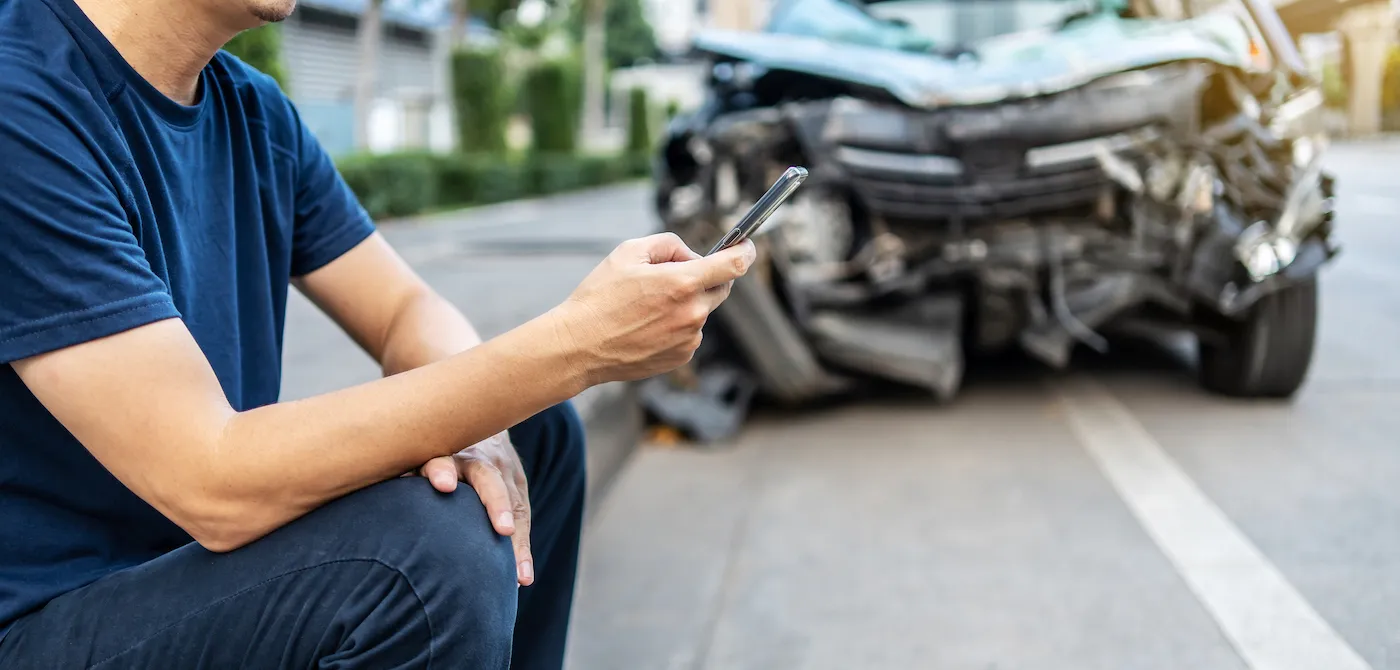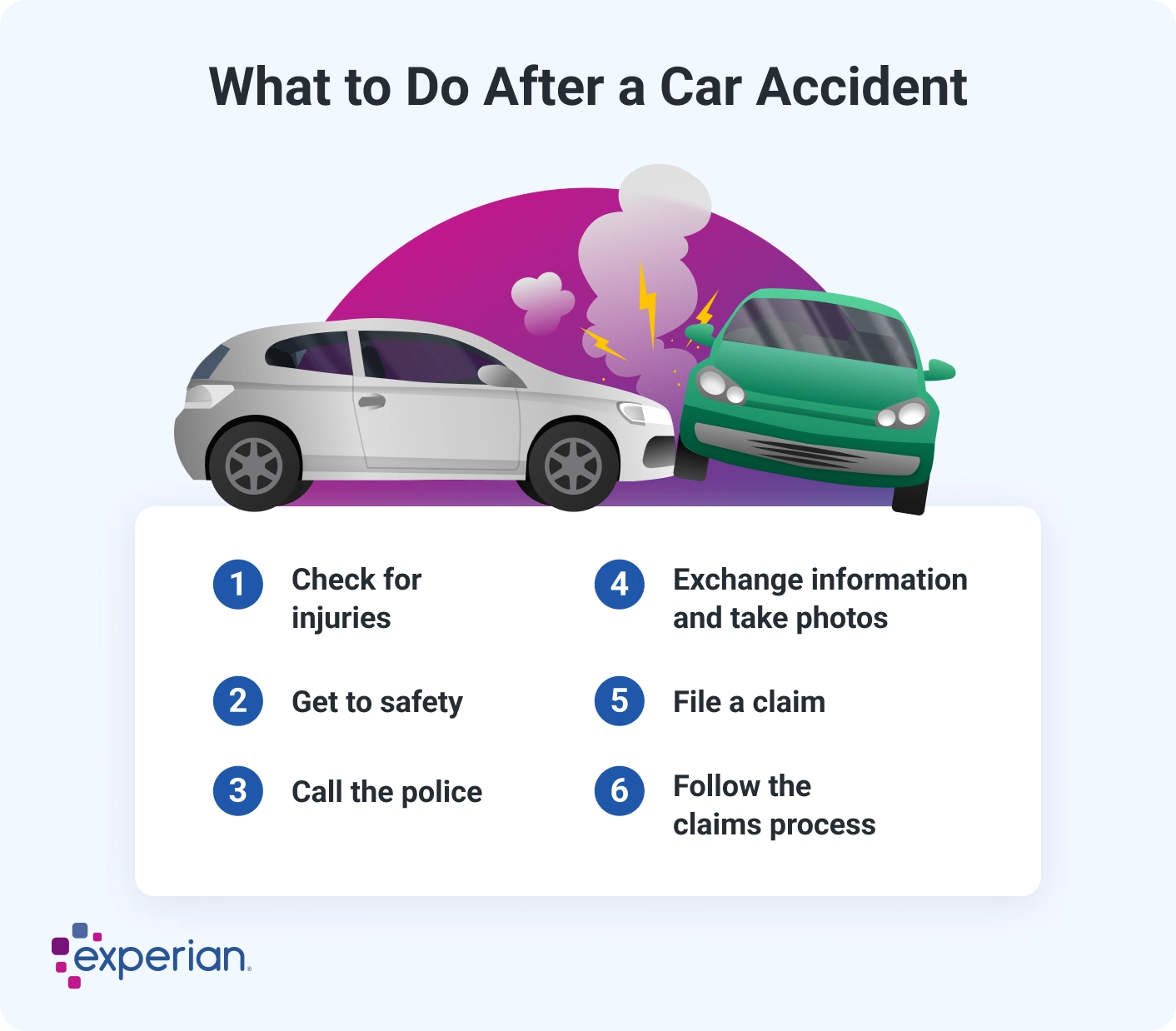What to Do After a Car Accident: Step-by-Step
Quick Answer
After a car accident, the first thing you should do is check for injuries and get to safety. If no one is seriously injured, then you can take the necessary steps to report, document and file a claim for your accident.

A car accident can be a stressful and overwhelming experience. But knowing what to do can help keep you safe, protect your legal rights and move you through the claims process efficiently. Taking the right steps immediately after an accident can help prevent delays and protect you from liability. To protect yourself and your finances, here's what to do after a car accident.

1. Check for Injuries
First, check yourself for injuries before trying to move. Look for visible injuries, like cuts, bruises or burns, and note any pain or discomfort. While you're still seated, try to move your limbs to check for full mobility. If you feel pain when moving, stop immediately. Symptoms like nausea or dizziness could be a sign of internal injury, so if you experience any of these symptoms, stay still and wait for medical attention, even if you don't feel any pain.
Next, if you're able, check on your passengers. Ask if they feel pain, dizziness or nausea since some injuries aren't always visible right away. Once you've checked yourself and everyone in your vehicle, check on the other driver and their passengers. If anyone is injured, call 911 right away or have someone else call, even if the injuries seem minor.
Tip: If you seem fine initially but experience delayed injuries, make sure to go to a doctor and inform your insurer to update your claim. Each state has different laws on how long you have to file a personal injury claim.
2. Get to Safety
If no one is seriously injured and your car is drivable, move it to a safe location such as the shoulder, emergency lane or median. This prevents a traffic jam and reduces the risk of a secondary accident. Turn on your hazard lights to increase visibility and warn other drivers.
Moving your vehicle doesn't mean you're admitting fault or liability for the accident. In fact, many states require drivers to move their vehicles after minor accidents, especially on busy roads like interstates, highways and exit ramps, to keep traffic flowing.
Before moving your car, check for fluid leaks, smoke or strange noises as these could indicate a mechanical issue. If your car is undrivable, stay inside and wait for assistance. In high-traffic areas, exiting your vehicle can put you at risk of being hit by another vehicle, so evaluate the situation before getting out of your car. Contact roadside assistance if your car needs towing or repairs.
3. Call the Police
Even if the accident seems minor, it's important to report it to the police. In some areas, officers may not respond unless there are injuries or significant damage, but calling them ensures you have an official record of the accident. You can file a report with the local police department if an officer doesn't arrive.
Tip: Police may not file a report if an accident occurs on private property and there are no injuries or crime.
A police report can be critical for determining fault and may be required by your insurance company when you file a claim. When the offer arrives, provide your driver's license, vehicle registration and proof of insurance. Stick to the facts when you're describing what happened and avoid speculating about fault or admitting responsibility. Get the officer's name and badge number and ask how you can obtain a copy of the report when it's ready.
4. Exchange Information and Take Photos
If the police respond to the accident, they'll typically collect and share information from all parties involved. However, if officers don't arrive, exchange information with the other driver.
Here's the information you'll want to exchange:
- Name, address and phone number
- Insurance company name and policy number
- Driver's license number and license plate number
- Vehicle make, model and color
- Contact information for any passengers or witnesses
Tip: Avoid admitting fault or discussing who caused the accident. Even apologizing could be interpreted as you admitting liability.
Take pictures of all vehicles, property damage, license plates, weather conditions and visible injuries. Capture photos from multiple angles so your insurer has enough information about the accident to determine who's at fault. Note the location of any surveillance or doorbell cameras nearby in case the footage is needed to help determine fault. And if you have a dashcam, make sure to save the footage.
5. File a Claim
Report the accident to your insurance company as soon as possible, while the details are still fresh. Many insurance companies offer multiple ways to file a claim: online, by calling your insurance agent or claims department, or using your insurer's mobile app.
When you're filing a claim, be prepared to provide details about the accident, including:
- The date, time and location of the accident
- The other driver's information
- Details about what happened
- Photos and documentation you collected
When you contact your insurance company, ask about your policy's comprehensive and collision coverage limits, deductible and rental car coverage to understand what expenses your insurance will cover.
Learn more: How to File an Insurance Claim
6. Follow the Claims Process
Your insurance company will assign a claims adjuster to work with you to assess the damage and determine fault (if you're in an at-fault state). You may have the option of having your vehicle repaired or accepting a payout. However, if you're financing or leasing your car, your lender may require you to get the vehicle repaired rather than keep the payment.
The claims process usually starts with scheduling an inspection so your insurance company can assess the damage and determine repair costs. If fault needs to be determined, the insurance company will review the evidence you've provided to make a decision. Then, if repairs are covered, the insurer will authorize a repair shop to begin work on your vehicle. If you have a deductible due, you'll pay it to the auto repair shop after your repairs are complete.
Most insurers allow you to choose your repair shop, though they recommend a preferred provider. If you choose your own repair shop, make sure your insurer will cover the full cost of repairs.
Keep records of your expenses, medical bills and communications with your insurance company. If there are disputes about fault, injuries or insurance coverage, you may need to consult with an attorney for legal guidance.
Learn more: What States Have No-Fault Insurance?
Frequently Asked Questions
The Bottom Line
Taking the right steps after a car accident can help ensure your safety, protect your legal rights and make the claims process smoother. Documenting the scene thoroughly will be beneficial for filing your insurance claim. After an accident, it's important to notify your insurance company as soon as possible to start the claims process and avoid delays.
If you're in the market for auto insurance, Experian's car insurance comparison tool can help you find the best coverage at a competitive price. Comparing quotes from multiple providers can help ensure you choose the right policy to fit your needs and budget.
Don’t overpay for auto insurance
If you’re looking for ways to cut back on monthly costs, it could be a good idea to see if you can save on your auto insurance.
Find savingsAbout the author
LaToya Irby is a personal finance writer who works with consumer media outlets to help people navigate their money and credit. She’s been published and quoted extensively in USA Today, U.S. News and World Report, myFICO, Investopedia, The Balance and more.
Read more from LaToya